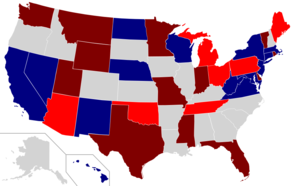- United States Senate elections, 1994
Infobox Election
election_name = United States Senate elections, 1994
country = United States
type = legislative
ongoing = no
previous_election = United States Senate elections, 1992
previous_year = 1992
next_election = United States Senate elections, 1996
next_year = 1996
seats_for_election = 34 seats in theUnited States Senate
election_date =November 8 ,1994
map_size = 320px
map_caption = legend|#800|Republican holdlegend|#f00|Republican pickupslegend|#008|Democratic holdtitle = Majority Leader
before_election =George Mitchell
before_party = Democratic Party (United States)
after_election =Bob Dole
after_party = Republican Party (United States)The U.S. Senate election, 1994 was an election held on November 8, in which the Republican Party was able to take control of the Senate from the Democrats by mobilizing voters discontented with congressional incumbents, the early presidency of
Bill Clinton , andHillary Rodham Clinton 's unsuccessful health care plan.The Republicans captured eight seats from the Democrats, including the seats of sitting Sens.
Harris Wofford (D-PA) andJim Sasser (D-TN), as well as six open seats inArizona ,Maine ,Michigan ,Ohio ,Oklahoma , andTennessee . Notably, since Sasser's defeat coincided with the special election to replaceAl Gore (who had left the Senate to become Vice President), Tennessee's Senate delegation switched from entirely Democratic to entirely Republican in a single election.This defeat changed control of the Senate from Democrats to Republicans for the first time since 1986. In combination with the first change of control in the
United States House of Representatives since 1954 and the Republicans' net gain of twelve governorships; this is sometimes called theRepublican revolution . Minority leader Robert J. Dole (R-Kan.) became majority leader, while on the Democratic side, the new minority leader was Thomas A. Daschle (D-S.D.), previous majority leader George J. Mitchell (D-Maine) having left the Senate.Initially, the balance was 52–48 in favor of the Republicans, but after the power change, Democrats
Richard Shelby ofAlabama andBen Nighthorse Campbell ofColorado switched parties, bringing the balance to 54–46 before the resignation ofBob Packwood ofOregon and his replacement by DemocratRon Wyden finalized the balance at 53–47.Notable races
Republican gains
*
Arizona : Three-term Democratic incumbentDennis DeConcini retired after being a member of theKeating Five Scandal. Republican CongressmanJon Kyl defeated his Democratic opponent, fellow CongressmanSam Coppersmith by a comfortable margin.
*Maine : One of the Republican's biggest prizes was the seat of retiring Majority LeaderGeorge Mitchell . Longtime CongresswomanOlympia Snowe gained the seat in a landslide victory over Democratic Congressman Thomas Andrews.
*Michigan : Democratic SenatorDonald W. Riegle, Jr. retired after three terms. FormerMichigan Republican Party ChairmanSpencer Abraham defeated Democratic CongressmanMilton Robert Carr in the race to succeed Riegle.
*Ohio : SenatorHoward Metzenbaum retired and his son-in-lawJoel Hyatt received the Democratic nomination to succeed him. Hyatt would go on to be badly defeated by Lieutenant GovernorMike DeWine .
*Oklahoma : The seat of DemocratDavid L. Boren opened up when he resigned to accept the Presidency of theUniversity of Oklahoma . Republican CongressmanJim Inhofe defeated the Democratic nominee, CongressmanDave McCurdy .
*Pennsylvania : DemocratHarris Wofford was appointed to the Senate when three-term Republican SenatorH. John Heinz III died in a 1991 plane crash. He won a special election to hold that seat later that year. In his tough re-election against Republican CongressmanRick Santorum , the pro-choice Wofford lost the endorsement of pro-life Democratic Governor Robert Casey. This contributed to his loss to Santorum by two percentage points.
*Tennessee (Class 1): One of the biggest upsets of the night was the defeat of three-term incumbent SenatorJim Sasser . Sasser had been the influential Chairman of the Budget Committee and was among the leading candidates to replace Mitchell as Democratic Floor Leader. Sasser, however, would be defeated by prominent Nashville heart surgeonBill Frist by a margin of 14 points.
*Tennessee (Class 2): Less surprising was the Republican victory in the other Tennessee Senate contest.Harlan Matthews had held the seat sinceAl Gore 's resignation to assume the Vice Presidency in 1993, but chose not to seek the Democratic nomination in the special election. The Republican nominee, actor and attorneyFred Thompson , defeated six-term Democratic CongressmanJim Cooper in an overwhelming landslide.Democratic holds
*
California :Dianne Feinstein won a special election in 1992 to fill the seat of GovernorPete Wilson . She faced liberal Republican CongressmanMichael Huffington in her race for a full term. Feinstein emerged victorious by less than two points.
*Massachusetts :Ted Kennedy usually coasted to re-election, but in this election he faced an unusually tough challenge from Republican businessmanMitt Romney . Though the final result was a 17 point Kennedy victory, it marked the first time since his initial election in 1962 that Kennedy received less than 60% of the vote.
*Virginia : DemocratChuck Robb received over 70% of the vote when first elected in 1988, but was not so fortunate when running for re-election. Furor over Robb's alleged affair with modelTai Collins provided plenty of momentum for the Republicans nominee,Iran-Contra figureOliver North . A factor to Robb's advantage was the independent candidacy of attorneyJ. Marshall Coleman . North likely lost votes to Coleman especially when Virginia's other Senator, RepublicanJohn Warner , endorsed Coleman over North. Robb received 46% of the vote to North's 43% with Coleman garnering 11%.enate contests in 1994
Winning candidates in boldRepublican pickups in red|Red
Wikimedia Foundation. 2010.


